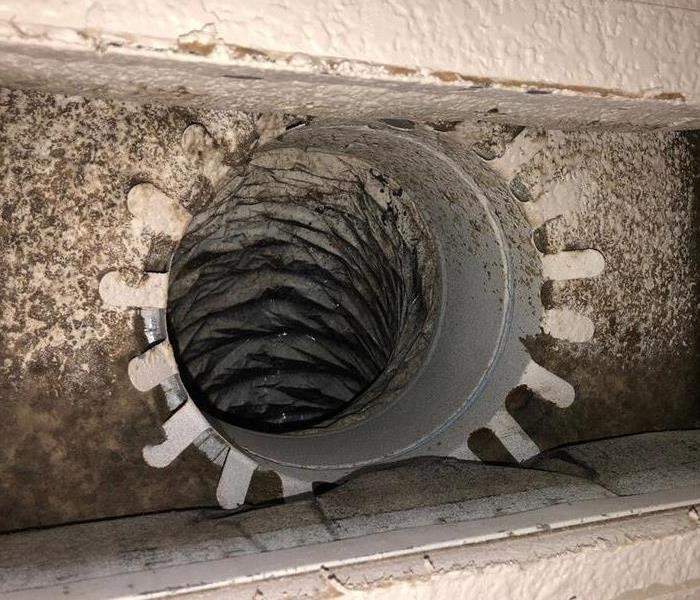Basic Facts about Mold and Dampness
4/20/2020 (Permalink)
Have a Mold Problem? Call SERVPRO of TRACY at 209.834.0200
Basic Facts about Mold and Dampness
How common is mold in buildings?
Molds are very common in buildings and homes. Mold will grow in places with a lot of moisture, such as around leaks in roofs, windows, or pipes, or where there has been flooding. Mold grows well on paper products, cardboard, ceiling tiles, and wood products. Mold can also grow in dust, paints, wallpaper, insulation, drywall, carpet, fabric, and upholstery.
The most common indoor molds are Cladosporium, Penicillium, and Aspergillus. We do not have precise information about how often different molds are found in buildings and homes.
How do molds get in the indoor environment and how do they grow?
Mold is found both indoors and outdoors. Mold can enter your home through open doorways, windows, vents, and heating and air conditioning systems. Mold in the air outside can also attach itself to clothing, shoes, and pets can and be carried indoors. When mold spores drop on places where there is excessive moisture, such as where leakage may have occurred in roofs, pipes, walls, plant pots, or where there has been flooding, they will grow. Many building materials provide suitable nutrients that encourage mold to grow. Wet cellulose materials, including paper and paper products, cardboard, ceiling tiles, wood, and wood products, are particularly conducive for the growth of some molds. Other materials such as dust, paints, wallpaper, insulation materials, drywall, carpet, fabric, and upholstery, commonly support mold growth.
How do you know if you have a mold problem?
Large mold infestations can usually be seen or smelled.
How do you keep mold out of buildings and homes?
Inspect buildings for evidence of water damage and visible mold as part of routine building maintenance, Correct conditions causing mold growth (e.g., water leaks, condensation, infiltration, or flooding) to prevent mold growth.
Inside your home you can control mold growth by:
- Controlling humidity levels;
- Promptly fixing leaky roofs, windows, and pipes;
- Thoroughly cleaning and drying after flooding;
- Ventilating shower, laundry, and cooking areas.
Specific Recommendations:
- Keep humidity levels as low as you can—between 30% and 50%–all day long. An air conditioner or dehumidifier will help you keep the level low. Bear in mind that humidity levels change over the course of a day with changes in the moisture in the air and the air temperature, so you will need to check the humidity levels more than once a day.
- Use an air conditioner or a dehumidifier during humid months.
- Be sure your home has enough ventilation. Use exhaust fans which vent outside your home in the kitchen and bathroom. Make sure your clothes dryer vents outside your home.
- Fix any leaks in your home’s roof, walls, or plumbing so mold does not have moisture to grow.
- Consider not using carpet in rooms or areas like bathrooms or basements that may have a lot of moisture.
How do you get the molds out of buildings, including homes, schools, and places of employment?
Mold growing in homes and buildings indicates that there is a problem with water or moisture. This is the first problem to address.
Remove moldy items from living areas. Once mold starts to grow in carpet, insulation, ceiling tiles, drywall, or wallboard, the only way to deal with the problem is by removal and replacement.
It is important to properly clean and dry the area as you can still have an allergic reaction to parts of the dead mold and mold contamination may recur if there is still a source of moisture.
Remove or replace carpets and upholstery that have been soaked and cannot be dried promptly.
Clean up and dry out your home thoroughly and quickly (within 24-48 hours) after any flooding. Dig out mud and dirt . Use a wet vacuum to remove remaining dirt. Scrub cleanable surfaces (such as wood, tile, stone) with soapy water and a bristle brush. Thoroughly clean all hard surfaces (such as flooring, molding, wood and metal furniture, countertops, and sinks) with water and dish detergent. Dry surfaces quickly and thoroughly after cleaning. If you have a fan, air conditioner or dehumidifier that wasn’t affected by flooding use it to help the surfaces dry after you finish cleaning
Mold growth can be removed from hard surfaces with commercial products, soap and water, or a bleach solution of no more than 1 cup (8 ounces) of bleach in 1 gallon of water to kill mold on surfaces. Never mix bleach with ammonia or other household cleaners.
If you choose to use bleach to clean up mold:
- Never mix bleach with ammonia or other household cleaners. Mixing bleach with ammonia or other cleaning products will produce dangerous, toxic fumes.
- Open windows and doors to provide fresh air.
- Wear non-porous gloves and protective eye wear.
- Small areas (such as a shower, or an area the size of a door) can often be cleaned by residents, but larger areas might need more professional help. Always follow the manufacturer’s instructions when using bleach or any other cleaning product.
If you have an extensive amount of mold and you do not think you can manage the cleanup on your own, you may want to contact a professional who has experience in cleaning mold in buildings and homes.

 24/7 Emergency Service
24/7 Emergency Service
